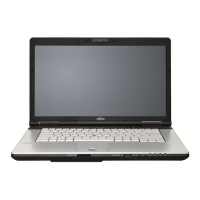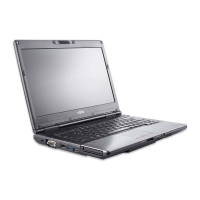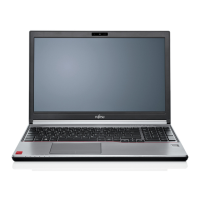Do you have a question about the Fujitsu Lifebook E780 and is the answer not in the manual?
Illustrates and identifies the various ports, buttons, and features on the notebook's exterior.
Provides a detailed explanation of the notebook's keyboard layout, including function and special keys.
Explains how to use the touchpad for cursor control, clicking, dragging, and scrolling.
Explains the function of the security and application panel for securing the notebook and launching applications.
Outlines the notebook's power sources: battery, AC adapter, and optional auto/airline adapter.
Provides step-by-step instructions for connecting the AC and optional auto/airline adapters.
Details the features and care of the notebook's Lithium ion battery.
Lists and explains error and status messages generated by the BIOS and operating system during startup.
Specifies the type of Intel Core processors supported by the notebook.
Details system memory specifications, including type, slots, and upgradeability.
Lists all the available ports on the notebook and optional port replicator.
Provides steps for configuring wireless network connectivity on Windows Vista/7.
Offers solutions for common problems encountered with wireless LAN connectivity.
Lists technical specifications for wireless LAN devices, including transfer rates and security.
Provides instructions for installing the OmniPass software, including system requirements.
Guides on enrolling a user into OmniPass, including master password concept and examples.
Addresses common issues with creating Windows users and adding them to OmniPass.
Illustrates and identifies the various ports, buttons, and features on the notebook's exterior.
Provides a detailed explanation of the notebook's keyboard layout, including function and special keys.
Explains how to use the touchpad for cursor control, clicking, dragging, and scrolling.
Explains the function of the security and application panel for securing the notebook and launching applications.
Outlines the notebook's power sources: battery, AC adapter, and optional auto/airline adapter.
Provides step-by-step instructions for connecting the AC and optional auto/airline adapters.
Details the features and care of the notebook's Lithium ion battery.
Lists and explains error and status messages generated by the BIOS and operating system during startup.
Specifies the type of Intel Core processors supported by the notebook.
Details system memory specifications, including type, slots, and upgradeability.
Lists all the available ports on the notebook and optional port replicator.
Provides steps for configuring wireless network connectivity on Windows Vista/7.
Offers solutions for common problems encountered with wireless LAN connectivity.
Lists technical specifications for wireless LAN devices, including transfer rates and security.
Provides instructions for installing the OmniPass software, including system requirements.
Guides on enrolling a user into OmniPass, including master password concept and examples.
Addresses common issues with creating Windows users and adding them to OmniPass.
| Bus type | DMI |
|---|---|
| Stepping | C2 |
| Tjunction | 105 °C |
| Processor cache | 3 MB |
| Processor cores | 2 |
| Processor model | i3-330M |
| System bus rate | 2.5 GT/s |
| Processor family | Intel® Core™ i3 |
| Processor series | Intel Core i3-300 Mobile Series |
| Processor socket | BGA 1288 |
| Processor threads | 4 |
| Processor codename | Arrandale |
| Processing Die size | 81 mm² |
| Processor frequency | 2.13 GHz |
| Processor cache type | Smart Cache |
| Processor lithography | 32 nm |
| Processor manufacturer | Intel |
| Processor front side bus | - MHz |
| PCI Express slots version | 2.0 |
| Processor operating modes | 64-bit |
| ECC supported by processor | No |
| PCI Express configurations | 1x16 |
| Thermal Design Power (TDP) | 35 W |
| Maximum number of PCI Express lanes | 16 |
| Number of Processing Die Transistors | 382 M |
| Motherboard chipset | Intel® QM57 Express |
| HDD speed | 5400 RPM |
| HDD interface | SATA |
| Optical drive type | DVD Super Multi |
| Card reader integrated | Yes |
| Total storage capacity | 320 GB |
| Display surface | Matt |
| Display diagonal | 15.6 \ |
| Display resolution | 1366 x 768 pixels |
| Native aspect ratio | 16:9 |
| Internal memory | 2 GB |
| Memory clock speed | 1066 MHz |
| Internal memory type | DDR3-SDRAM |
| Maximum internal memory | 8 GB |
| Memory layout (slots x size) | 1 x 2 GB |
| Audio system | HD Audio |
| Front camera resolution (numeric) | 1.3 MP |
| Type | PC |
| Modem speed | 56 Kbit/s |
| Wireless technology | 802.11 b/g/n |
| Compliance industry standards | WMI, PXE, BootP |
| Bluetooth version | 2.1+EDR |
| Networking features | Gigabit Ethernet, WLAN |
| Trial software | Symantec Norton Internet Security |
| Bundled software | Adobe Acrobat Reader Application Panel Display Manager ShockSensor Utility Power Saving Utility Wireless Selector Utility EasyGuide Nero Essentials S Norton Internet Security |
| Operating system installed | Windows 7 Professional |
| Optional operating system supplied | Windows XP Professional |
| Battery capacity | 5200 mAh |
| Battery life (max) | 7 h |
| Number of battery cells | 6 |
| Charging port type | DC-in jack |
| USB 2.0 ports quantity | USB 2.0 ports have a data transmission speed of 480 Mbps, and are backwards compatible with USB 1.1 ports. You can connect all kinds of peripheral devices to them. |
| Parallel ports quantity | 0 |
| CardBus PCMCIA slot type | Type II |
| Cable lock slot type | Kensington |
| Password protection type | BIOS |
| Pointing device | Touchpad |
| Keyboard key pitch | 19 mm |
| Keyboard keystroke | 2.7 mm |
| Keyboard number of keys | 86 |
| Operating temperature (T-T) | 5 - 35 °C |
| Operating relative humidity (H-H) | 20 - 85 % |
| AC adapter power | 80 W |
| AC adapter input voltage | 100 - 240 V |
| AC adapter output current | 4.22 A |
| AC adapter output voltage | 19 V |
| Battery life with optional 2nd battery | 11 h |
| Discrete graphics card model | Intel® HD Graphics |
| On-board graphics card base frequency | 500 MHz |
| On-board graphics card dynamic frequency (max) | 667 MHz |
| Processor code | SLBNF |
| Processor ARK ID | 47663 |
| Processor package size | rPGA 37.5x 37.5, BGA 34x28 mm |
| Graphics & IMC lithography | 45 nm |
| Supported instruction sets | SSE4.1, SSE4.2 |
| Depth | 255 mm |
|---|---|
| Width | 372 mm |
| Height | 36 mm |
| Weight | 2700 g |











